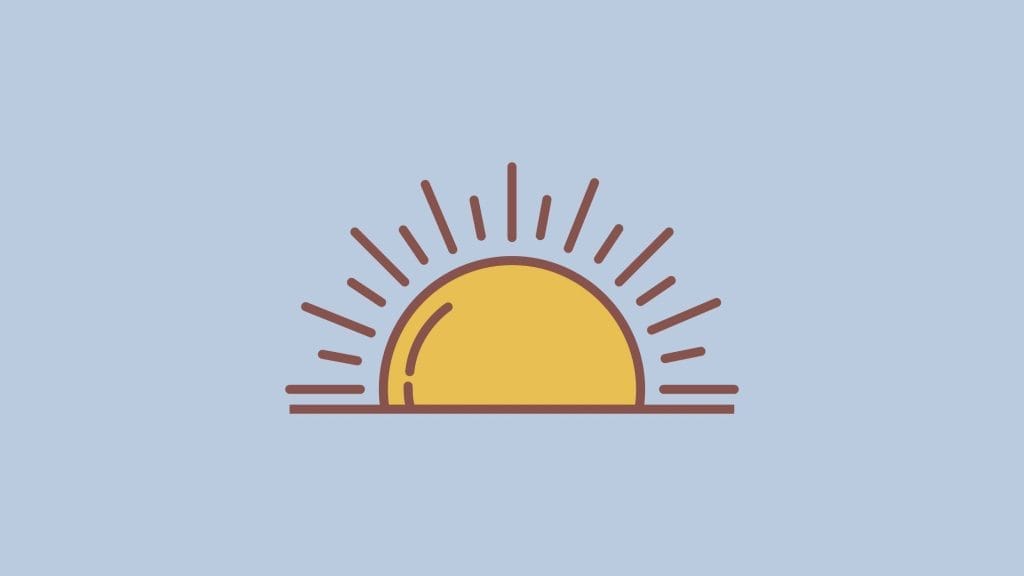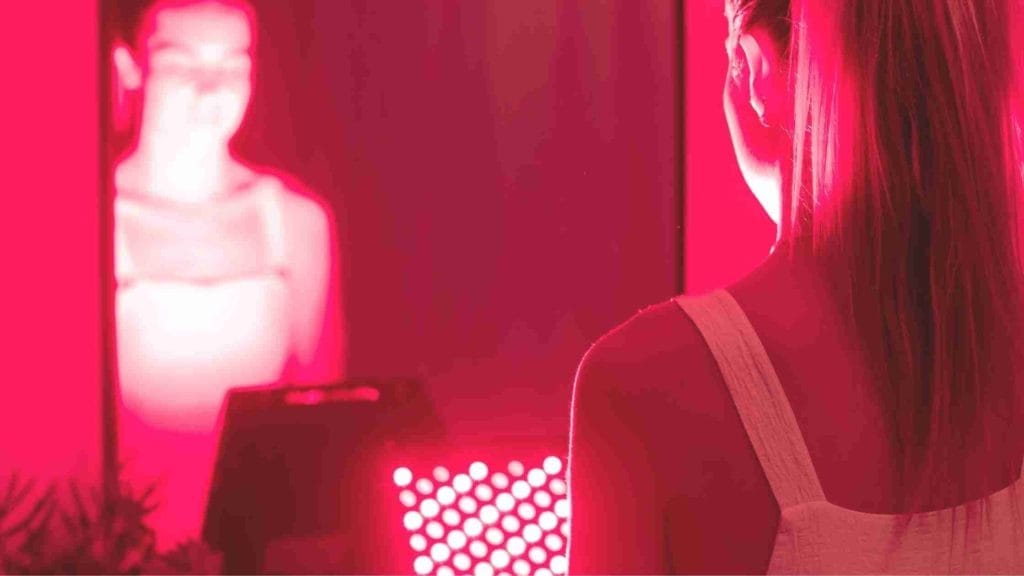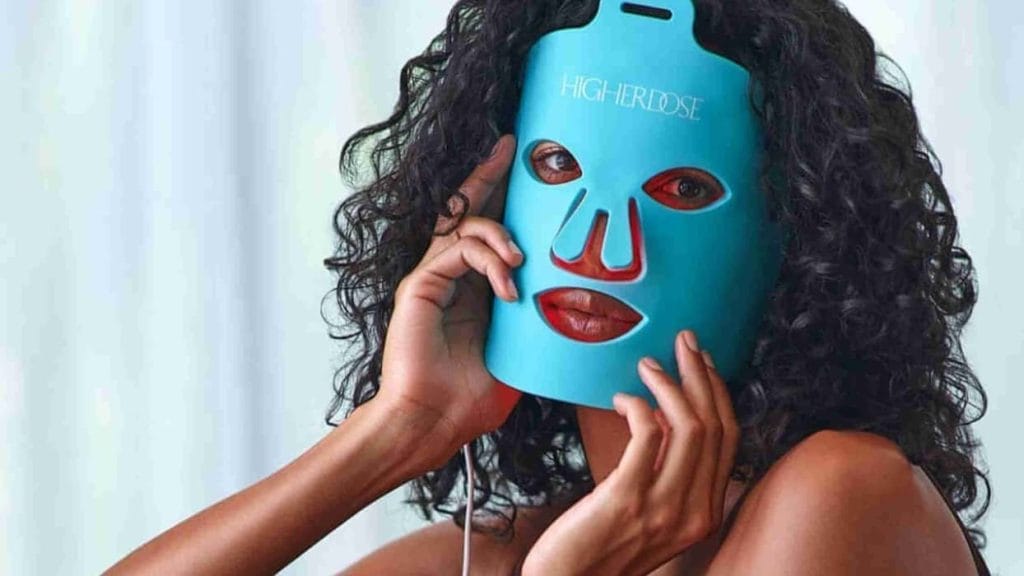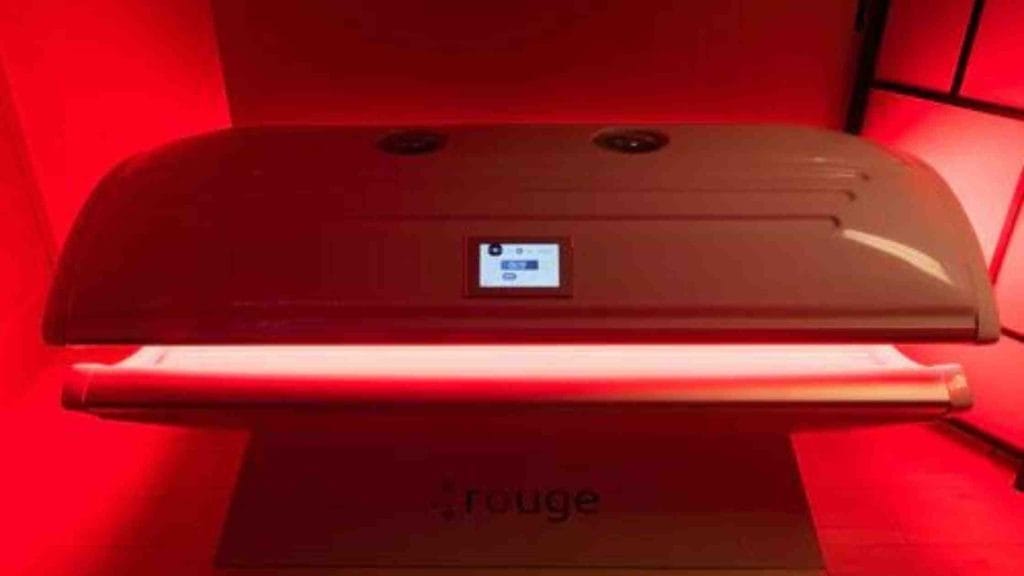Using Sunlight, Blue Light and Red Light Therapy Devices To Optimise Health
We include links to products we think are useful for our readers. If you click and buy a product through one of the affiliate links on this page, we may earn a small commission.

Sunlight, Red Light and Blue Light
Light from sunlight, blue light and red light from red light therapy devices can be used as powerful tools to improve health and affect things like circadian rhythm and sleep cycles, hormone function, energy levels, skin health, mood and recovery and repair.
Recently, Dr Andrew Huberman did a podcast in which he details the mechanisms by which different wavelengths of light impact the cells, tissues and organs of the human body, and how specifically timed light exposure of specific wavelengths can be used to improve sleep, enhance alertness, modulate hormone levels, and improve mood.
The science that is discussed by Huberman in the Huberman Lab Podcast about light therapy provides evidence based tools including the use of red light therapy devices, infrared saunas, pulsed light, led devices and natural sunlight exposure to relieve pain, increase testosterone, and estrogen levels, improve skin health and treat things like acne, wound healing, and how red light can benefit age related vision loss and provide neuroprotective qualities.
In this article, I will summarise the key takeaways about light-based therapies that are most likely making more regular appearances on your Instagram and Tiktok feeds in the form of red light masks, LED masks, pulsed light devices, red light wands, red light panels, infrared saunas, infrared sauna blankets and other popular photo therapies. By the end of this article you will have an understanding about the benefits of red light therapy, the benefits of getting natural sunlight everyday, the best red light therapy devices and panels in 2022 and how you can use the physics of light to heal, recover and improve your mood.
A brief summary of the Andrew Huberman Light Exposure Podcast
Humans can not see infrared light with the naked eye, however the affects of infrared light energy can have unique health benefits relating to cell repair, injury repair, mood, healthy hormone function clearing skin issues;
UV light viewed for just a few minutes a day can reduce pain perception;
Different wavelengths of light can penetrate tissues to different depths. For example, longer wavelength light like infrared light in the form of near infrared light and visible red light can penetrate deeper into the tissues compared to other light wavelengths like blue light, green light and UV light;
Light is a powerful signalling mechanism that can significantly impact sleep quality, circadian rhythms, energy levels and mitochondrial function and mood.
Light is energy
Research has shown that “the variation of light is by far the most important factor in setting and maintaining our natural daily rhythm, the so-called circadian rhythm”, as described by Jens Christpherson in the paper The importance of light to health and wellbeing.
All light moves through space with a different wavelength and different spectrums of light have the ability to penetrate differing depths. Evidence suggests that low light-exposure is associated with diminished health and well-being and it can lead to reduced sleep quality, depressed mood, lack of energy and reduced social relations.
Exposure to natural light and other light sources like red light and infrared light have the ability to affect us on a cellular level. Getting the right amount of sun during daylight hours and minimising light exposure in the night hours, therefore, is a key to optimal health and vitality.
We really do need light to survive, as do most living organisms on earth. The average human circadian cycle is a little longer than 24 hours and varies from 23.9 hours to 24.5 hours. During this cycle the biological clock is affected via a specific neural pathway from the eye, which responds to the level of light exposure during the cycle. This is the pathway that generates important physiological and behavioural circadian rhythms such as the sleep/wake cycle, temperature and hormone secretion which equate to huge measures of energy, mood, sleep, the aging process, skin health, executive function and most other functions of the body really.
So, it is true that we can use deliberate and conscious light exposure practices to be the healthiest, fittest and strongest versions of ourselves and produce the most desirable conditions for recovery.
Using Sunlight Exposure for Optimal Health
According to experts, how light affects the visual system or circadian rhythm can be divided into five functions; intensity, spectrum, timing, duration and spatial distribution. Without delving too deep into this, what you need to know is that the time, type, total and location of light exposure is important to consider.
Light can be translated into electrical signals and can actually change the gene expression. There is a history of more than 100 years of using light to modulate the activity of cells in the brain and body to heal, originating from the Noble Prize winning treatment for Lupus.
In a recent podcast, Dr. Andrew Huberman outlines how you can use light exposure for optimising health. Basically, in short days, the duration of melatonin release will be longer. In longer days, the duration of melatonin release will be shorter. We use light to determine where we are in the world and at what time. In the summer months, we should take advantage of the increased length of light and get outside more and in the winter months it makes more sense to get less sun and stay indoors more.
Our relationship with light relates back to our biological clock and can even relate to our desire to mate or have sex. During summer months, there is more seeking out of mates and more desire for mating behaviour and during winter this is reduced.
To take away a few simple recommendations from the Huberman podcast on light as well as the science that he references, we should expose ourselves to at least 30 minutes of direct sunlight to the skin and eyes each day, preferably in the morning upon waking, to set the natural cycle and trigger hormones that helps us stay in a healthy cycle. Ideally, this light should be received on the naked eye without sunglasses and on bare skin to get the best affect. At the other end of the day, into the night hours, we should conversely get less light, especially less blue light, to avoid its negative effects on sleep and disruption of sleep producing hormones.
Benefits of Red Light and Infrared Light

Red light and infrared light can benefit skin health, hair loss, sleep cycles, energy levels, wound healing, acne and pain management.
Red light therapy has been shown to be effective at treating a number of health conditions and is being investigated for efficacy in treating many more.
How does red light therapy work? Red light therapy in the form of visible red light and infrared light rays, is said to penetrate beyond the layers of the skin and acts on the body’s “power plant”, being our mitochondria. By improving mitochondrial function, red light allows the cells to function more efficiently while dead cells are removed more effectively. is thought to work by acting on the “power plant” in your body’s cells called mitochondria. This translates into faster recovery, more rapid skin and wound healing, new cell growth, faster hair growth, and beneficial release of hormones promoting sleep. Exposure to red light earlier in the day allows the cells to replenish ATP.
For skin health, red light therapy is said to stimulate collagen production, increase fibroblast production, increase blood flow and reduce inflammatory cells which all contribute to better overall skin appearance and health.
Red light therapy has been studied for offsetting vision loss in 40 years or older, 1-3 minutes done a few times per week.
Best Red Light Therapy Devices

Red light therapy devices were once only accessible in a medical setting but are now a common tool that can be used at home. Red light therapy devices can come in the form of red light panels, red light wands, red light masks, red light torches, red light helmets and even full red light beds.
A red light therapy device generally produces both visible red light and infrared light in the ranges of 600-750nm.
Red light therapy devices can be designed to cover the whole body, like in a red light therapy bed or red light panel, or for targeted treatment areas, like red light therapy helmets for hairloss, red light or LED face masks for skin treatment, or red light therpay wands for pigmentation and scarring.
Below is an explanation of some common red light therapy devices that can be used to get the benefits of red light therapy at home.
Red Light Panel
Red light therapy panels provide a broader application of red light and infrared light therapy to the level of the whole body. Red light panels come in a large array of sizes and can be bought in small, handheld and portable panels, medium sized half-body panels, and larger full body panels that can be linked together to form large walls of red light to give full body exposure.
Read Also: The Best Red Light Therapy Panels In 2022 – Reviews and Buyers Guide
We have tested a handful of red light panels over periods of low level light therapy and the effects on skin, mood, sleep and wound healing are real. Most of the red light panels available commercially are designed for illumination of the skin and come in illumination ranges of about 660-790nm or red and infrared light.
Hot tip: when using red light therapy from any red light therapy device, if the source of light hurts your eyes and causes you to want to squint, then you should be wearing eye protection. Most quality red light panels will include eye protection goggles to use during light therapy which protect the eyes from overexposure however it can also be beneficial to get some red light and infrared light onto the naked eye.
Red Light Wands
Red light wands provide a more concentrated, focussed application of red light and infrared light on a small area of the skin. Red light wands have increased in popularity in recent months as a very portable and lightweight red light therapy device that can be carried in a bag, purse, toiletries case, or baggage for travelling with.
Buy the Solawave Red Light Wand on Amazon
A red light wand will only be effective on small, isolated areas of the skin and are good for treating small patches of acne, lesions, scars and pigmentation. Generally, most red light wands are not designed to provide a broad beam of light delivered to the eyes so some of the benefits of getting red light exposure to the eyes wont be achieved.
Red light wands range in price between $30-250 and can also come in rechargeable options that provide up to 6 hours of continuous red light per charge. Red light wands are compact and can be as small as 10cm in length and weigh as little as 200 grams which shows their suitability for travel or as a red light device for home that doesn’t take up much space.
There are also other similar red light therapy devices that are suitable portable alternatives like the DNA Vibe Red Light Band.
Red Light Masks

You’ve probably seen a red light therapy mask or LED mask ad pop up on your Instagram or Tiktok feed lately if you are someone who regularly searches health and wellness related terms or more specific terms like ‘best red light mask’ or ‘red light face mask’. Red light therapy masks are designed purely for red light and infrared light therapy on the face.
Buy the HigherDOSE Red Light Mask for $299
Most of the desired benefits of red light masks would be to improve acne, to reduce acne scarring, reduce skin lesions, reduce pigmentation of the face, help with dermatitis, reduce wrinkles and repair skin cells in general. All of these benefits are definitely scientifically associated with red light and infrared light produced from a red light mask and regular use of red light is safe and extremely low risk.
Buy Project E LED Mask for $149 on Amazon
Most red light masks range in price between $90-350 and generally come in an adjustable mask that has similar contours to the average face and provides a nice even light across the whole face. The benefit of a red light mask is that it holds the light source at a constant distance from the face that is suitable for red light therapy allowing the wavelengths to penetrate below the dermis where it needs to go to repair damaged cells.
The downside of a red light mask is that it is not so much designed to be used for red light therapy on the body. Unlike a red light panel, that can be used on a broad treatment area on the body including large areas like the lower back or chest, red light masks are only really useful for the face. Choosing a red light mask vs red light panel vs red light wand comes down to your budget and which parts of the body you are hoping to hit with red light treatment.
Red Light Beds

Rouge Red Light Bed
A red light therapy bed is similar to a solarium style bed and comes in the form of a capsule that can partially close over the body and floods the whole body with red light and infrared light.
A red light therapy bed is generally quite an expensive option for red light therapy but is the most effective option for achieving full body cover. Most red light therapy beds range in price from $10000-$30000. A red light therapy bed is more of a device that you would find in a boutique wellness treatment space, but if you have the budget to install one at home, there are a number of great options like the Rouge Bliss Full Body Immersion Bed or the Rouge Curve.
Protocols For Using Light To Improve Health
I have personally used many of the light therapy and sunlight exposure protocols mentioned in the Andrew Huberman podcast as well as other simple photobiomodulation practices over the last year and there are a few simple practices that I can recommend to incorporate into your daily routine for affecting recovery exercise, getting better sleep, waking up with more energy, reducing acne and skin issues like Perioral Dermatitis and Vitiligo, reducing pain levels, and increasing testosterone. Here are the top 6 tips to incorporate every day and night relating to light therapy and using light for health:
Keep the lights off after sunset
Neurobiologist, Andrew Huberman, states that exposure to UVB light during sleep hours or roughly between 8pm and 4am, even for just a short period of time like the few seconds of turning on the lights to go the bathroom at night, will significantly impact melatonin release and negatively impact sleep quality.
Keeping lights either very dim or completely switched off after sunset will set the most desirable conditions to produce the hormones beneficial for sleep (melatonin) and keep those non-conducive to sleep (cortisol) low.
Exercise within 30 minutes of waking
Exercising within half an hour of waking is a fantastic way to set the sleep-wake cycle in motion and will contribute to being able to fall asleep fast, sleep through the night, and wake up with the sun without feeling tired.
I know, jumping on an assault bike, rowing machine or pounding the pavement within 30 minutes of waking is a big ask for most people. If you can drag yourself out of bed and commit to one day per week of this practice you will be able to gradually increase the days until it becomes a tenable habit.
Using an infrared sauna or steam sauna can also be considered as exercise in the morning as it produces very similar physiological responses to actual exercise. I personally love jumping into a sauna in the morning for 20-30 minutes and combining this practice with cold plunge or ice baths for contrast therapy that has some incredible benefits for endorphin release, increasing brown fat, producing shock proteins and reducing inflammation and pain.
Daily exposure to 30 minutes of natural sunlight
Natural sunlight exposure is the superior form of light therapy hands down. Have you ever noticed that you feel a little more sad, more depressed or lower mood during the winter months? This feeling, which can also be called seasonal affective disorder for some people, has alot to do with the reduced amount of sunlight that the body and eyes are exposed to in the shorter days and reduced periods of sunlight in winter months.
Getting sun on the body has loads of benefits that can affect everything from wound healing, to sleep cycles, to testosterone levels, and even perceived attractiveness. Not only that, Exposing to UVB light equivalent to 30 minutes per day of natural sunlight exposure for 3-4 days a week has been found to increase testosterone and estrogen, increase mood, increase energy, higher levels of romantic passion in emotional and sexual form, increased tolerance for pain.
A note on sunscreen: by all means, practice whatever sun safe practices you think necessary, but know that sunscreen, particularly those with a high SPF rating, are blocking a lot of the positive effects of UVB exposure. Not only that, many sunscreens have been found to have a ridiculous amount of bad chemicals within the ingredients that are doing you no good!
Getting at least 30 minutes of light exposure early in the day, and even pairing this with exercise, will have some pretty strong effects on producing signals for waking and start an important timing mechanism in the body to later produce melatonin for sleep. By getting some natural sunlight and exercise in the morning, cortisol is produced to encourage a wakeful state.
Pro tip: If you are someone who generally reaches for coffee within minutes of waking, research has shown that if you delay your caffeine intake by 30 minutes after waking, you allow the “burn off” of adenosine which is blunted by caffeine and causes an afternoon crash. Simply, consume coffee a little later in the morning and you may not get the post lunch crash. Alternatively, it might be a good time to check out some alternatives to coffee and try a caffeine fast period.
Use red light for reading at night
As mentioned earlier, using bright lights after sunset is not ideal for getting a good sleep. Using a red light for reading at night solves this issue and removes exposure to UVB light from standard lights that can blunt melatonin release.
Red lights for reading range in price from $10-$100 and there is an option for every budget. Some red lights for reading can be clipped onto the bedhead or straight onto the book you are reading and others can be in the form of red light reading lamps. You can even buy specially designed red light globes and bulbs to fit to your existing light fixtures.
Red lights for reading is an easy way to reduce exposure to UVB or blue light before bed which has been shown to significantly impact ability to fall asleep quickly and easily. Red light from a red light lamp does not negatively impact the release of melatonin, the sleep hormone, while still, providing adequate light for reading.
A red light for bed is also a suitable option for couples who may have different bed time routines. By reading with a red light, you can reduce the impact you have with light pollution and aggressive lighting and have a softer red light that is far less annoying for your partner trying to sleep while you read or work in bed.
Wear blue light blocking glasses
The eyes are the most sensitive part of the body for receiving light signals to communicate what time of day it is and where you hormones should be positioned for your sleep-wake cycle. Blue light blocking glasses are the best solution for people who use mobile phones, computers, watch TV or scroll Instagram and Tiktok before bed.
Obviously, the ideal practice is to minimise phone and device use after sunset hours as constantly being connected has other implications on brain activity and hormones like cortisol which are detrimental to sleep. But, as an easy way to combat the bad effects of blue light, we recommend a good pair of blue light blocking glasses to wear after sunset when using intense lighting at night, using mobile phones before bed or working on a computer or laptop in the night.
Related Article: Block Blue Light Blue Light Blocking Glasses Review
Blue blocking glasses with an orange or red lense or tint are essential for blocking 100% of harmful blue light rays. Some blue blocking glasses have a clear lense and are more suited for day time use, but are not effective for night time use and will not block enough blue light to avoid the melatonin blunting effects. Do your research when buying blue light blocking glasses online as they are not all created equally.
Using a red light therapy device daily
Red light therapy devices for home like red light panels are another scientifically proven tool for improving sleep hygiene and setting good light exposure practices to start the day and set in motion a good circadian rhythm.
Research has shown that using red light and infrared light therapy, or low level light therapy (LLLT) in the morning for 10-20 minutes promotes signals to the body that are effective at setting circadian rhythms and making it easier to wake up and break sleep inertia.
Conclusion on Light Therapy
Light exposure is essential for good health. Completely avoiding sunlight and overprotecting the body from getting sun is actually detrimental to our health and is a sure way to limit your health potential. Getting daily exposure to natural sunlight for at least 30 minutes and using red light therapy devices like red light panels or red light beds is a great way to deliver beneficial light wavelengths to improve cellular function which can improve sleep, skin, mood, energy, hair growth and ageing.
While blue light is safe during the day and is in fact part of the natural spectrum of light that we get from the sun, we should be limiting our blue light exposure in the hours after sunset so that we allow for the natural release of sleep producing hormones. By getting the right light at the right time of day and switching off the lights at night or wearing blue light blockers, we can maintain a healthy circadian rhythm and fall asleep fast and wake up easily. Maintaining good light therapy practices is a simple way to ensure the best possible health and wellbeing and the fastest recovery times.
Smarter recovery for humans…

